Applying a Set of Potential Methods for the Integrated Assessment of the Marine Eco-Environmental Carrying Capacity in Coastal Areas
Abstract
:1. Introduction
2. Materials and Methods
2.1. Study Area
2.2. Procedure and Methods
2.2.1. Step I: Framework for the Establishment of an Assessment Indicator System
2.2.2. Step II: Methods of Indicator Normalization and Weighting
2.2.3. Step III: A Quantitative Analysis Method for MECCA
2.3. Data Collection
3. Results
3.1. Establishing an Assessment Indicator System
3.2. Calculation and Distribution of the Indicator Weight
3.3. Comprehensive Evaluation of MECC
4. Discussion
4.1. Results Analysis
4.2. Proposed Corresponding Coastal Managing Measures
4.3. Providing a Practicable Approach for Integrated MECCA in Coastal Areas
5. Conclusions
Author Contributions
Funding
Institutional Review Board Statement
Informed Consent Statement
Data Availability Statement
Acknowledgments
Conflicts of Interest
References
- Barbier, E.B.; Hacker, S.D.; Kennedy, C.; Koch, E.W.; Stier, A.C.; Silliman, B.R. The value of estuarine and coastal ecosystem services. Ecol. Monogr. 2011, 81, 169–193. [Google Scholar] [CrossRef]
- Seto, K.C. Exploring the dynamics of migration to mega-delta cities in Asia and Africa: Contemporary drivers and future scenarios. Glob. Environ. Chang. 2011, 21, 94–107. [Google Scholar] [CrossRef]
- Wang, G.; Fang, Q.; Zhang, L.; Chen, W.; Chen, Z.; Hong, H. Valuing the effects of hydropower development on watershed ecosystem services: Case studies in the Jiulong river watershed, Fujian province, China. Estuar. Coast. Shelf Sci. 2010, 86, 363–368. [Google Scholar] [CrossRef] [Green Version]
- Halpern, B.S.; Frazier, M.; Afflerbach, J.; Lowndes, J.S.; Micheli, F.; O’Hara, C.; Scarborough, C.; Selkoe, K.A. Recent pace of change in human impact on the world’s ocean. Sci. Rep. 2019, 9, 11–19. [Google Scholar] [CrossRef] [Green Version]
- Li, Y.F.; Xiang, Z.Y.; Chen, K.L.; Wang, X.Y. An improved spatial subsidy approach for ecological compensation in coastal seascapes for resilient land-sea management. J. Environ. Manag. 2020, 276, 111–120. [Google Scholar] [CrossRef] [PubMed]
- Bianco, F.; García-Ayllón, S. Coastal resilience potential as an indicator of social and morphological vulnerability to beach management. Estuar. Coast. Shelf Sci. 2021, 253, 107290. [Google Scholar] [CrossRef]
- Wu, K.K.; Zhang, L.P. Application of environmental risk assessment for strategic decision-making in coastal areas: Case studies in China. J. Environ. Plan. Manag. 2016, 59, 826–842. [Google Scholar] [CrossRef]
- Broman, G.I.; Robèrt, K.H. A framework for strategic sustainable development. J. Clean. Prod. 2017, 140, 17–31. [Google Scholar] [CrossRef]
- Navarro Jurado, E.; Tejada, M.; Almeida García, F.; Cabello González, J.; CortesMadas, R.; Delgado Pena, J.; Fernández Gutiérrez, F.; Guti´ errezFernández, G.; LuqueGallego, M.; MálvarezGarcía, G.; et al. Carrying capacity assessment for tourist destinations. Methodology for the creation of synthetic indicators applied in a coastal area. Tour. Manag. 2012, 33, 1337–1346. [Google Scholar] [CrossRef]
- Malthus, T. An Essay on the Principle of Population; Pickering: London, UK, 1798; pp. 154–196. [Google Scholar]
- United Nations Educational, Scientific and Cultural (UNESCO). Food and Agriculture Organization of the United Nations (FAO), 1985. Carrying Capacity Assessment with a Pilot Study of Kenya: A Resource Accounting Methodology for Sustainable Development; UNESCO: Paris, France; FAO: Rome, Italy, 2016; pp. 10–34. [Google Scholar]
- Smaal, A.; Prins, T.; Dankers, N. Minimum requirements for modeling bivalve carrying capacity. Aquat. Ecol. 1997, 31, 423–428. [Google Scholar] [CrossRef]
- Prato, T. Fuzzy adaptive management of social and ecological carrying capacities for protected areas. J. Environ. Manag. 2009, 90, 2551–2557. [Google Scholar] [CrossRef] [PubMed]
- Peng, B.; Li, Y.; Elahi, E.; Wei, G. Dynamic evolution of ecological carrying capacity based on the ecological footprint theory: A case study of Jiangsu province. Ecol. Indic. 2019, 99, 19–26. [Google Scholar] [CrossRef]
- Liu, R.; Pu, L.; Zhu, M.; Huang, S.; Jiang, Y. Coastal resource-environmental carrying capacity assessment: A comprehensive and trade-off analysis of the case study in Jiangsu coastal zone, eastern China. Ocean. Coast. Manag. 2020, 186, 50–62. [Google Scholar] [CrossRef]
- Millennium Ecosystem Assessment. Ecosystems and Human Well-Being: A Framework for Assessment; Island Press: Washington, DC, USA, 2005; pp. 25–36. [Google Scholar]
- Islam, R.; Khan, F.; Abbassi, R.; Garaniya, V. Human error assessment during maintenance operations of marine systems—What are the effective environmental factors? Saf. Sci. 2018, 107, 85–98. [Google Scholar] [CrossRef]
- Han, M.; Lu, G.; Shi, L.; Zhang, C.; Yu, H. Comprehensive carrying capacity assessment of Dongying coastal zone. ChinaPopul. Resour. Environ. 2017, 27, 9–13. [Google Scholar] [CrossRef]
- Chi, Y.; Shi, H.; Zheng, W.; Sun, J.; Fu, Z. Spatiotemporal characteristics and ecological effects of the human interference index of the yellow river delta in the last 30 years. Ecol. Indic. 2018, 39, 1219–1220. [Google Scholar] [CrossRef]
- Barbier, E.B.; Koch, E.W.; Silliman, B.R.; Hacker, S.D.; Wolanski, E.; Primavera, J.; Granek, E.F.; Polasky, S.; Aswani, S.; Cramer, L.A.; et al. Coastal ecosystem–based management with nonlinear ecological functions and values. Science 2008, 319, 321–323. [Google Scholar] [CrossRef]
- Li, Y.F. An Integrated Methodology for Assessment of Marine Eco-environment Carrying Capacity in Shandong Peninsula. Master’s Thesis, Institute of Oceanography, Chinese Academy of Sciences, Qingdao, China, 2014. [Google Scholar]
- Liu, J.Y.; Chen, S.D.; Jiang, T.J. Research on marine eco-environmental carrying capacity-a case study in eastern coast ocean of Shenzhen. Mar. Environ. Sci. 2017, 36, 560–565. [Google Scholar]
- Zheng, L.Y.; Bi, X.D.; Song, L.; Dong, S.J. Evaluation of marine ecological environment carrying capacity and obstacle diagnosis for Bohai Sea Ring Area of China based on entropy and catastrophe progression method. Mar. Sci. Bull. 2018, 37, 591–600. [Google Scholar] [CrossRef]
- United Nations. The Second World Ocean Assessment (World Ocean Assessment II). 2021. Available online: https://www.un.org/regularprocess/ (accessed on 21 April 2021).
- Lane, M. The carrying capacity imperative: Assessing regional carrying capacity methodologies for sustainable land-use planning. Land Use Policy 2010, 27, 1038–1045. [Google Scholar] [CrossRef] [Green Version]
- Smaal, A.C.; Schellekens, T.; Stralen, M.R.; Kromkamp, J.C. Decrease of the carrying capacity of the Oosterschelde estuary (SW Delta, NL) for bivalve filter feeders due to overgrazing? Aquaculture 2013, 40, 28–34. [Google Scholar] [CrossRef]
- Wang, S.; Ling, X.; Yang, F.; Wang, H. Assessment of water ecological carrying capacity under the two policies in Tieling city on the basis of the integrated system dynamics model. Sci. Total Environ. 2014, 47, 1070–1081. [Google Scholar] [CrossRef]
- Zhang, M.; Liu, Y.; Wu, J.; Wang, T. Index system of urban resource and environment carrying capacity based on ecological civilization. Environ. Impact Assess. Rev. 2018, 68, 90–97. [Google Scholar] [CrossRef]
- Shi, Y.; Shi, S.; Wang, H. Reconsideration of the methodology for estimation of land population carrying capacity in Shanghai metropolis. Sci. Total Environ. 2019, 652, 367–381. [Google Scholar] [CrossRef] [PubMed]
- Mou, S.; Yan, J.; Sha, J.; Deng, S.; Gao, Z.; Ke, W.; Li, S. A comprehensive evaluation model of regional water resource carrying capacity: Model development and a case study in Baoding, China. Water 2020, 12, 2637. [Google Scholar] [CrossRef]
- Zhang, F.; Ju, S.; Chan, N.W.; Ariken, M.; Tan, M.L.; Yushanjiang, A.; Wang, Y. Coupled analysis of new urbanization quality (NUQ) and eco-environmental carrying capacity (EECC) of prefecture-level and above cities in China during 2003–2016. Environ. Dev. Sustain. 2021, 23, 1–31. [Google Scholar] [CrossRef]
- McKindsey, C.W.; Thetmeyer, H.; Landry, T.; Slivert, W. Review of recent carrying capacity models for bivalve culture and recommendations for research and management. Aquaculture 2006, 261, 451–462. [Google Scholar] [CrossRef] [Green Version]
- Byron, C.; Link, J.; Costa-Pierce, B.; Bengtson, D. Calculating ecological carrying capacity of shellfish aquaculture using mass-balance modeling: Narragansett Bay, Rhode Island. Ecol. Modeling 2011, 222, 1743–1755. [Google Scholar] [CrossRef]
- Rios-Jara, E.; Galvan-Villa, C.M.; Rodriguez-Zaragoza, F.A.; Lopez-Uriarte, E.; Oz-Fernandez, M.T. The tourism carrying capacity of underwater trails in isabel island national park. Mex. Environ. Manag. 2013, 52, 335–347. [Google Scholar] [CrossRef]
- Zhang, Z.; Lu, W.X.; Zhao, Y.; Song, W.B. Development tendency analysis and evaluation of the water ecological carrying capacity in the Siping area of Jilin Province in China based on system dynamics and analytic hierarchy process. Ecol. Model. 2014, 275, 9–21. [Google Scholar] [CrossRef]
- Wang, M. The Study of Coupling Relationship between Marine Economic Development Potential and Marine Resources and Environment Carrying Capacity in the Coastal Areas of China. Master’s Thesis, Liaoning Normal University, Dalian, China, 2016. [Google Scholar]
- Xing, C.C.; Zhao, B.; Liu, N.N.; Liu, X.Q.; Sun, L.L.; Yang, K. The evaluation index system and the evaluation method of marine resource and environment carrying capacity in China. Ocean. Dev. Manag. 2019, 8, 33–35. [Google Scholar] [CrossRef]
- Wu, K.K.; Zhang, L.P.; Fang, Q.H. An approach and methodology of environmental risk assessment for strategic decision-making. J. Environ. Assess. Policy Manag. 2014, 16, 1–13. [Google Scholar] [CrossRef]
- Fang, Q.H.; Zhang, R.; Zhang, L.P.; Hong, H.S. Marine Functional Zoning in China: Experience and Prospects. Coast. Manag. 2011, 39, 656–667. [Google Scholar] [CrossRef]
- Hosseini, S.; Oladi, J.; Amirnejad, H. The evaluation of environmental, economic and social services of national parks. Environ. Dev. Sustain. 2021, 23, 9052–9075. [Google Scholar] [CrossRef]
- Wong, H.; Hu, B.Q. Application of improved extension evaluation method to water quality evaluation. J. Hydrol. 2014, 50, 539–548. [Google Scholar] [CrossRef]
- Daily, G.C.; Ehrlich, P.R. Socioeconomic equity, sustainability, and earth’s carrying capacity. Ecol. Appl. 1996, 6, 991–995. [Google Scholar] [CrossRef]
- Meng, F.; Guo, J.; Guo, Z.; Lee, J.C.K.; Liu, G.; Wang, N. Urban ecological transition: The practice of ecological civilization construction in China. Sci. Total Environ. 2021, 755, 142–156. [Google Scholar] [CrossRef]
- Che, Z.W.; Che, Z.S.; Li, G. Investigation and evaluation on environmental quality in Sanya Bay. J. Hainan Norm. Univ. 2009, 22, 70–82. [Google Scholar] [CrossRef]
- Li, L.; Li, Z.Z. Research progress on coastal geomorphology and sedimentary environment of Sanya Bay in Hainan. Open J. Nat. Sci. 2016, 4, 392–400. [Google Scholar] [CrossRef]
- Walz, R. Development of environmental indicator system: Experiences from Germany. J. Environ. Manag. 2000, 25, 613–623. [Google Scholar] [CrossRef]
- Qu, Y.B.; Zhu, W.Y.; Yun, W.J.; Zhang, Y.; Gao, Y. Land consolidation spatial pattern and diagnosis of its obstacle factors based on pressure-state-response model. Trans. Chin. Soc. Agric. Eng. 2017, 33, 241–248. [Google Scholar]
- Hazbavi, Z.; Sadeghi, S.H. Watershed health assessment using the pressure–state–response (PSR) framework. Land Degrad. Dev. 2020, 31, 3–19. [Google Scholar] [CrossRef]
- Lin, T.; Xue, X.Z.; Lu, C.Y. Analysis of Coastal Wetland Changes Using the “DPSIR” Model: A Case Study in Xiamen, China. Coast. Manag. 2007, 35, 289–303. [Google Scholar] [CrossRef]
- Sarmadi, H.; Salehi, E.; Kusari, N. The mega city of tehran water quantity assessment based on dpsir model. J. Phys. Conf. Ser. 2021, 18, 34–47. [Google Scholar] [CrossRef]
- Cao, H.J. An initial study on DPSIR model. Environ. Sci. Technol. 2005, 28, 109–113. [Google Scholar] [CrossRef]
- Malmir, M.; Javadi, S.; Moridi, A.; Neshat, A.; Razdar, B. A new combined framework for sustainable development using the dpsir approach and numerical modeling. Geosci. Front. 2021, 14, 260–273. [Google Scholar] [CrossRef]
- Lukas, M.A. Regularization Method. In Encyclopedia of Environmetrics; El-Shaarawi, A.H., Piegorsch, W.W., Eds.; John Wiley & Sons, Ltd.: New York, NY, USA, 2006; pp. 281–304. [Google Scholar] [CrossRef]
- Sohn, H. Effects of environmental and operational variability on structural health monitoring. Philos. Transactions. Math. Phys. Eng. Sci. 2007, 365, 539–560. [Google Scholar] [CrossRef]
- Boysen, A.K.; Heal, K.R.; Carlson, L.T.; Ingalls, A.E. Best-matched internal standard normalization in liquid chromatography-mass spectrometry metabolomics applied to environmental samples. Anal. Chem. 2017, 33, 1363–1369. [Google Scholar] [CrossRef]
- Doherty, J.; Skahill, B.E. An advanced regularization methodology for use in watershed model calibration. J. Hydrol. 2006, 327, 564–577. [Google Scholar] [CrossRef]
- Tan, Y.Y. Carrying Capacity of Marine Resource, Ecology and Environment and Its Application in Bohai Bay Rim. Ph.D. Thesis, Ocean University of China, Qingdao, China, 2010. [Google Scholar]
- Hunter, M.D. State Space Modeling in an Open Source, Modular, Structural Equation Modeling Environment. Struct. Equ. Model. 2017, 25, 307–324. [Google Scholar] [CrossRef]
- Cross, L.; Cockburn, J.; Yue, Y.; O’Doherty, J.P. Using deep reinforcement learning to reveal how the brain encodes abstract state-space representations in high-dimensional environments. Neuron 2020, 109, 568–570. [Google Scholar] [CrossRef] [PubMed]
- Xu, D.L.; Li, Y.Q. Marine eco-environmental carrying capacity assessment based on state-space method. Stat. Decis. Mak. 2013, 18, 56–60. [Google Scholar] [CrossRef]
- DEEHP (Department Ecology and Environment of Hainan Province). Regional Spatial Eco-Environment Assessment and "Three Control Lines and Environmental Admission List” in Sanya City. 2019. Available online: http://hnsthb.hainan.gov.cn/xxgk/0200/0202/hjywgl/hjyxpj/201903/t20190308_2401882.html (accessed on 10 January 2019).
- SCEEB (Sanya City Ecology and Environment Bureau). Marine Ecology and Environment Status Bulletin in Sanya City (2015–2020). 2020. Available online: http://hbj.sanya.gov.cn/sthjsite/zjgbxx/202106/289b859dbe59473fbb6d4be6163d1fe6.shtml (accessed on 6 June 2021).
- TPGSC (The People’s Government of Sanya City). Aquaculture Waters and Mudflat Planning in Sanya City (2018–2030). 2018. Available online: http://www.sanya.gov.cn/sanyasite/zfwj/201809/679f2be791774b3e8ec6263b09a228a1.shtml (accessed on 18 August 2019).
- SCEEB (Sanya City Ecology and Environment Bureau). The “13rd Five-Year Plan” of Ecological Construction and Environmental Protection of Sanya City. 2018. Available online: http://hbj.sanya.gov.cn/sthjsite/jhghxx/202112/966cad0c22424fe3bf901ec2986eb30c.shtm (accessed on 6 December 2018).
- SCSB (Sanya City Statistical Bureau). Yearbook of Sanya City (2015–2020); China Statistics Press: Beijing, China, 2020.
- TPGSC (The People’s Government of Sanya City). The “13rd Five-Year Plan” for the Development of Sanya’s Marine Economy. 2016. Available online: http://www.sanya.gov.cn/sanyasite/szfwjxx/201605/26e3235d3eff42808ed8b46fa0ae1ea9.shtml (accessed on 13 May 2016).
- TPGSC (The People’s Government of Sanya City). Sanya Ecological Civilization Construction and Development Plan (2018–2025). 2019. Available online: http://www.sanya.gov.cn/sanyasite/szfwjxx/201909/cf4c2434a6094528bc222b8d8bf87d52.shtml (accessed on 19 September 2019).
- TPGSC (The People’s Government of Sanya City). Statistical Bulletin of National Economic and Social Development in Sanya City (2015–2020); China Statistics Press: Beijing, China, 2020.
- Oberholster, P.J.; Madlala, T.; Blettler, M.; Amsler, M.L.; Botha, A. An eutrophication index for lowland sandy rivers in Mediterranean coastal climatic regions of Southern Africa. River Res. Appl. 2019, 36, 35–40. [Google Scholar] [CrossRef]
- Du, W.; Wang, F.; Li, M. Effects of environmental regulation on capacity utilization: Evidence from energy enterprises in China. Ecol. Indic. 2020, 11, 106–117. [Google Scholar] [CrossRef]
- Ma, Y.Y.; Zhang, Q.F.; Chen, Y.Z.; Tu, J.B.; Sun, H.; Bo, W.J.; Gao, W.S. The exemplary verification and amendment suggestion of the index system and evaluation method of marine resources and environment carrying capacity monitoring and early-warning—A case study of Hangu Sea Area of Tianjin. Ocean. Dev. Manag. 2018, 11, 52–57. [Google Scholar] [CrossRef]
- Bricker, S.B.; Ferreira, J.G.; Simas, T. An integrated methodology for assessment of estuarine trophic status. Ecol. Model. 2003, 169, 39–60. [Google Scholar] [CrossRef] [Green Version]
- Zhao, Y.; Xue, X.Z.; Huang, Y.; Kong, H. Evaluating comprehensive carrying capacity of coastal area using the matter-element extension method: A case study in Fujian Province of China. Ocean. Coast. Manag. 2021, 214, 21–31. [Google Scholar] [CrossRef]
- Su, Z.L.; Yuan, G.H.; Hao, Q. Carrying capacity assessment of marine ecological environment based on entropy method-A case study of coastal waters of Guangxi Province. Nat. Resour. Econ. China 2018, 31, 13–19. [Google Scholar] [CrossRef]
- Wei, C.; Guo, Z.Y.; Wu, J.P.; Ye, S.F. Constructing an assessment indices system to analyze integrated regional carrying capacity in the coastal zones-a case in Nantong. Ocean. Coast. Manag. 2014, 93, 51–59. [Google Scholar] [CrossRef]
- Heron, E.; Heron, R.; Taylor, L.; Lundquist, C.J.; Greenaway, A. Remaking ocean governance in Aotearoa New Zealand through boundary-crossing narratives about ecosystem-based management. Mar. Policy 2020, 122, 2–22. [Google Scholar] [CrossRef]
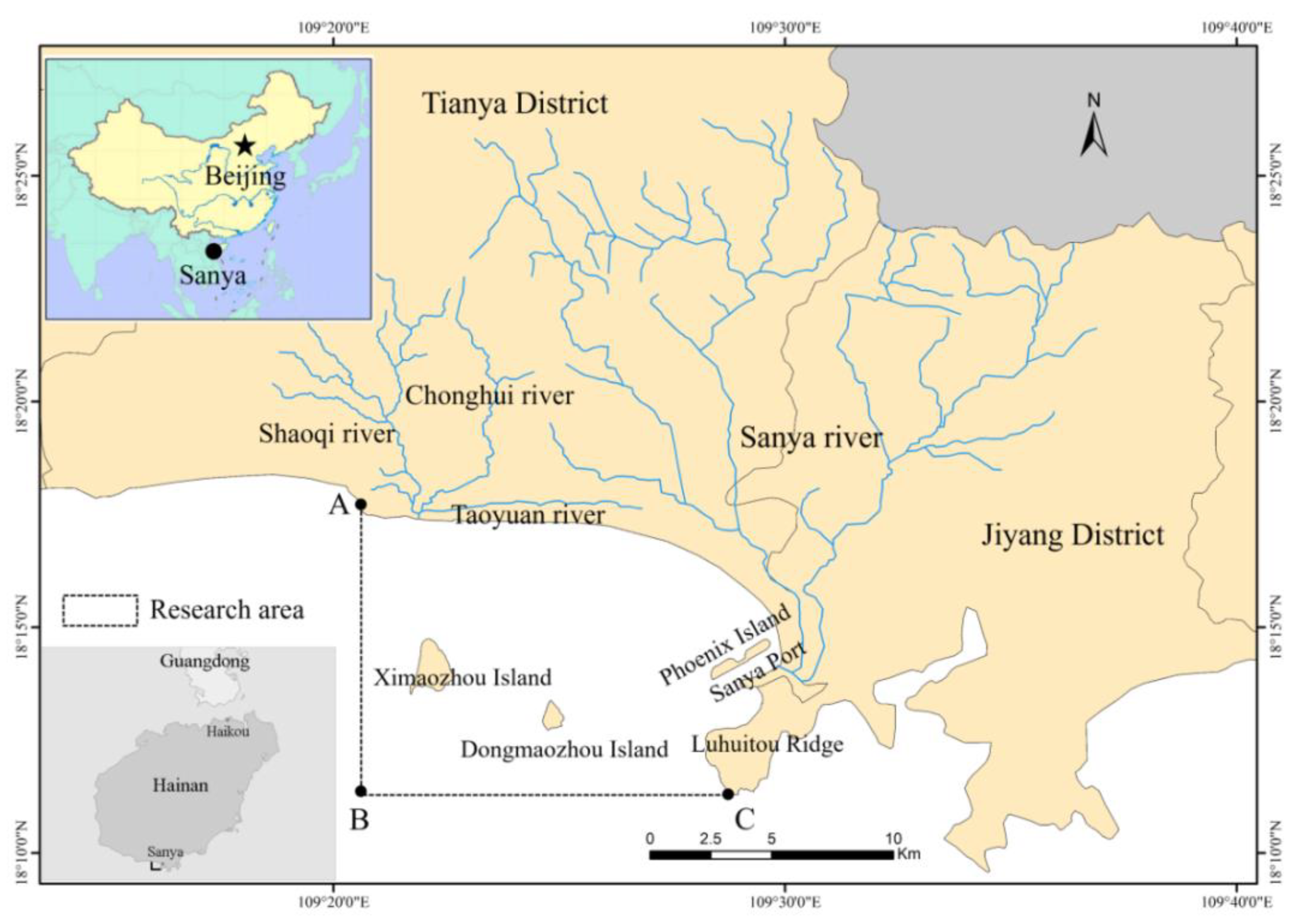
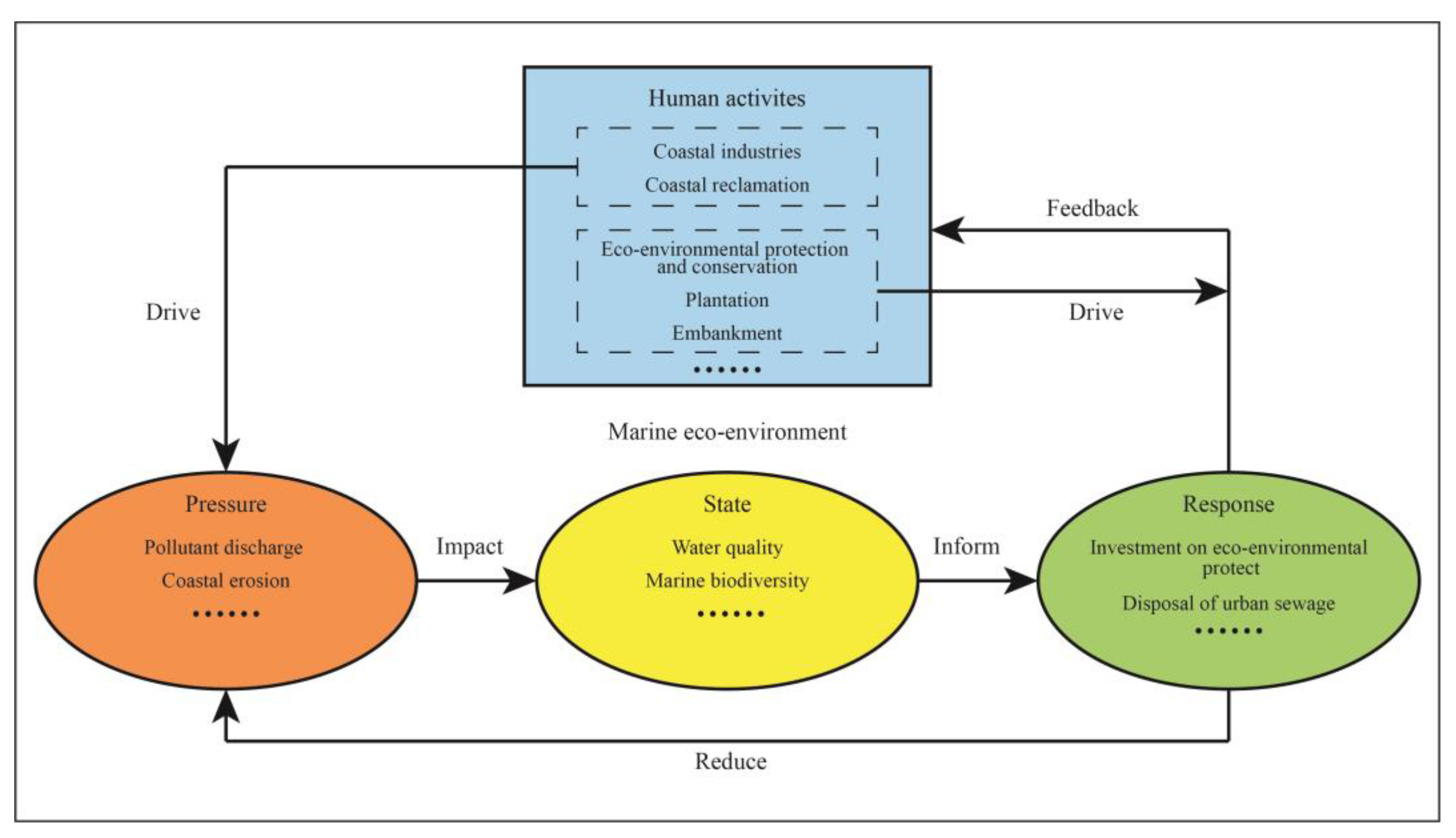
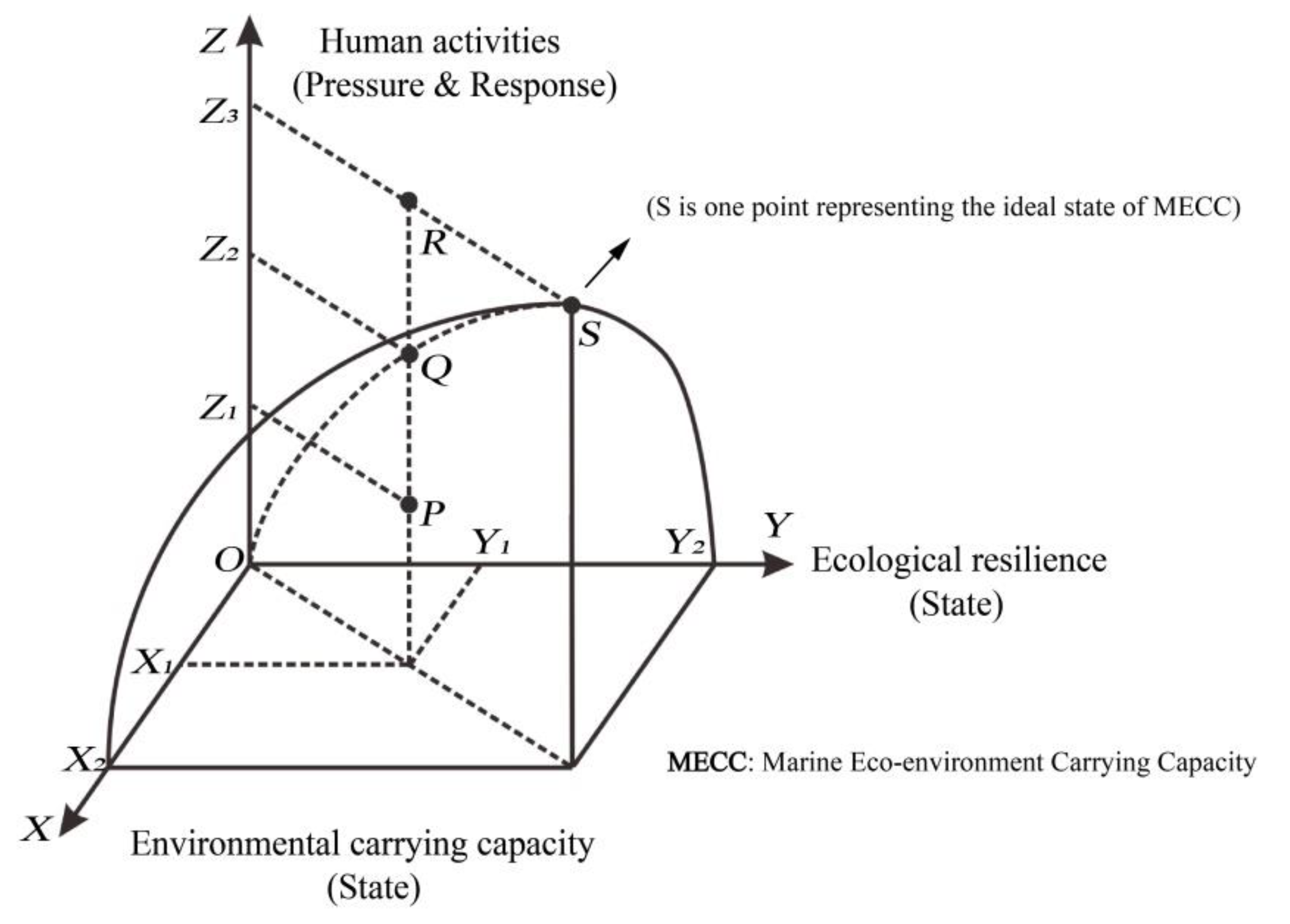
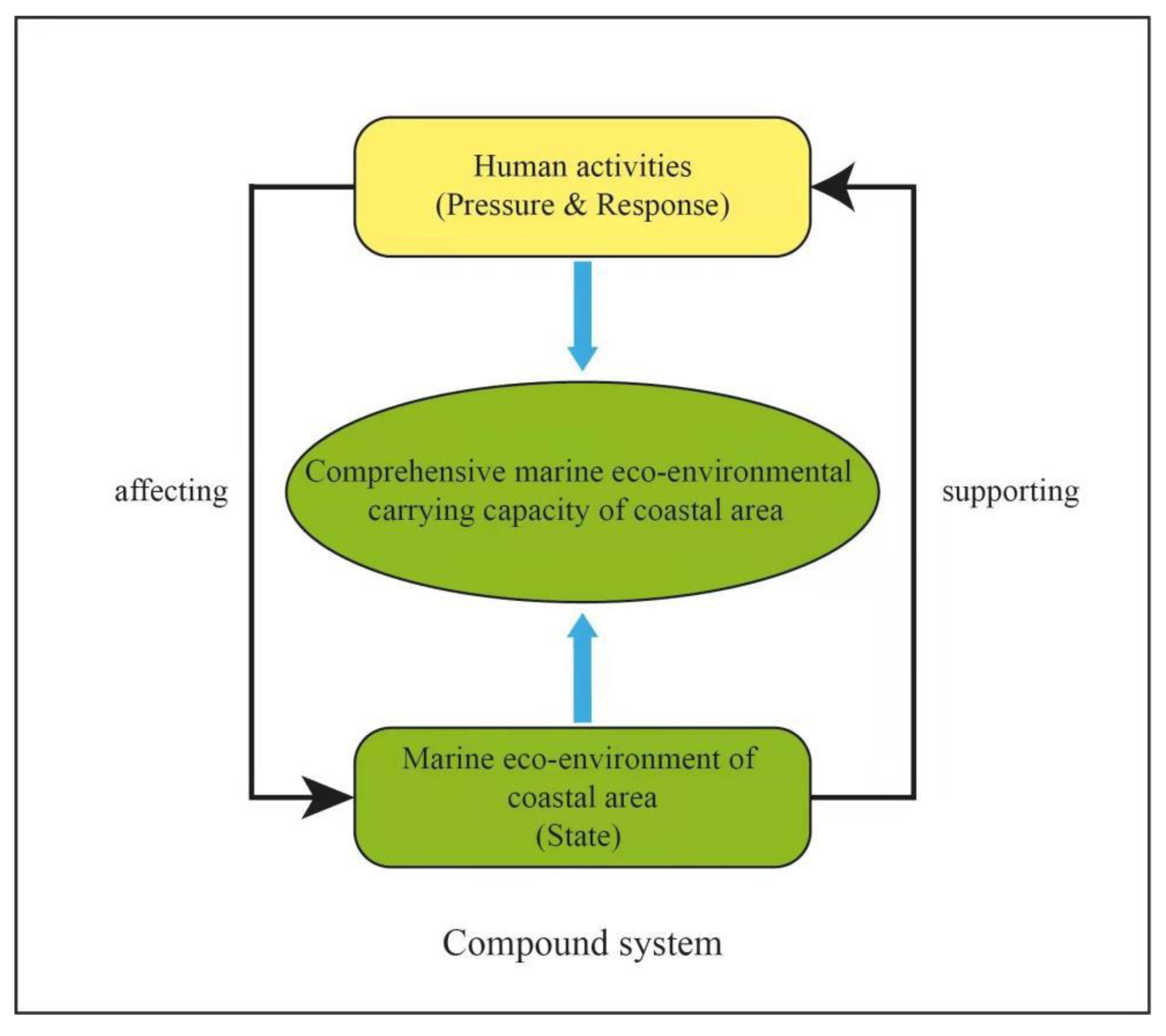
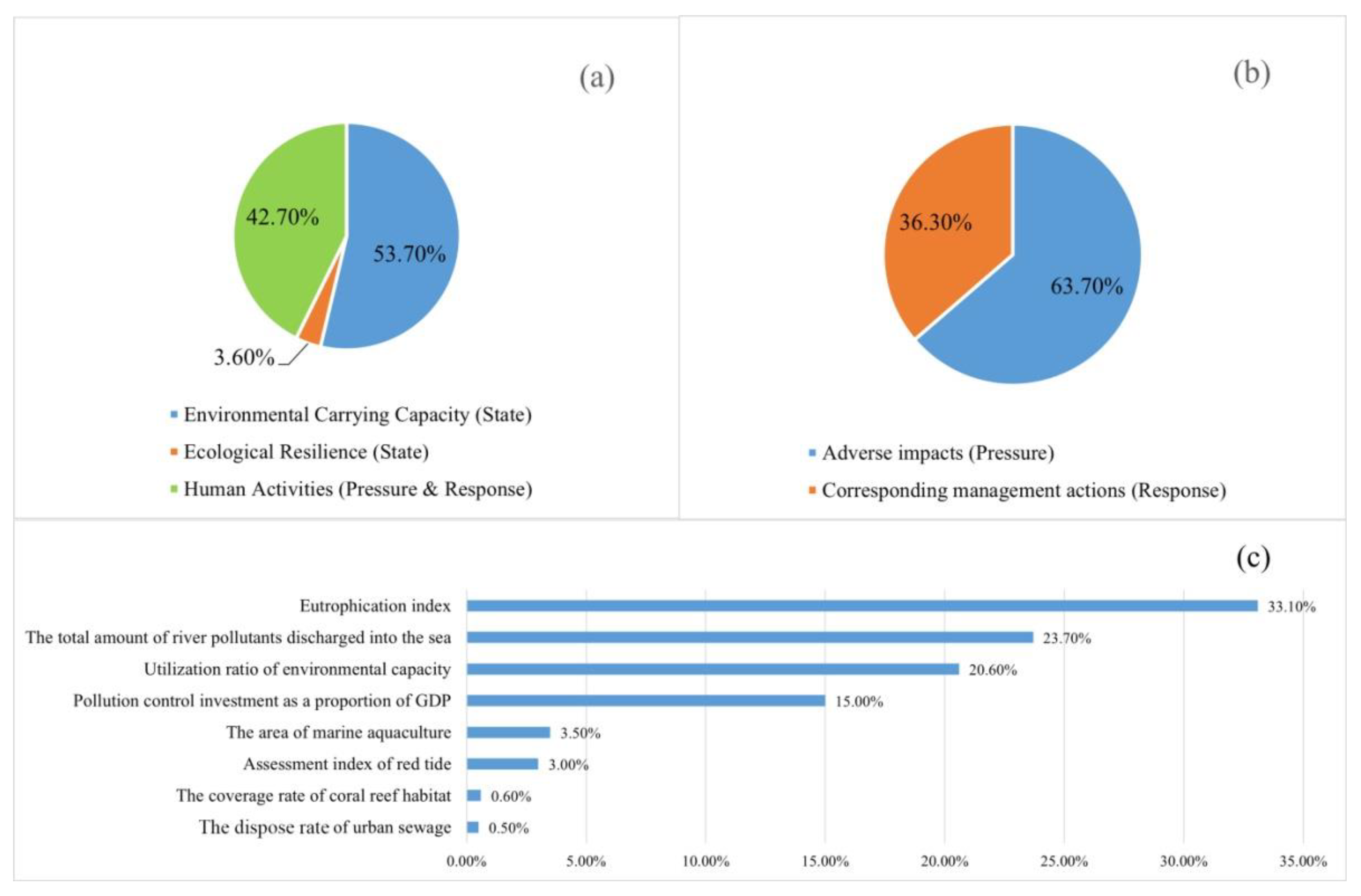
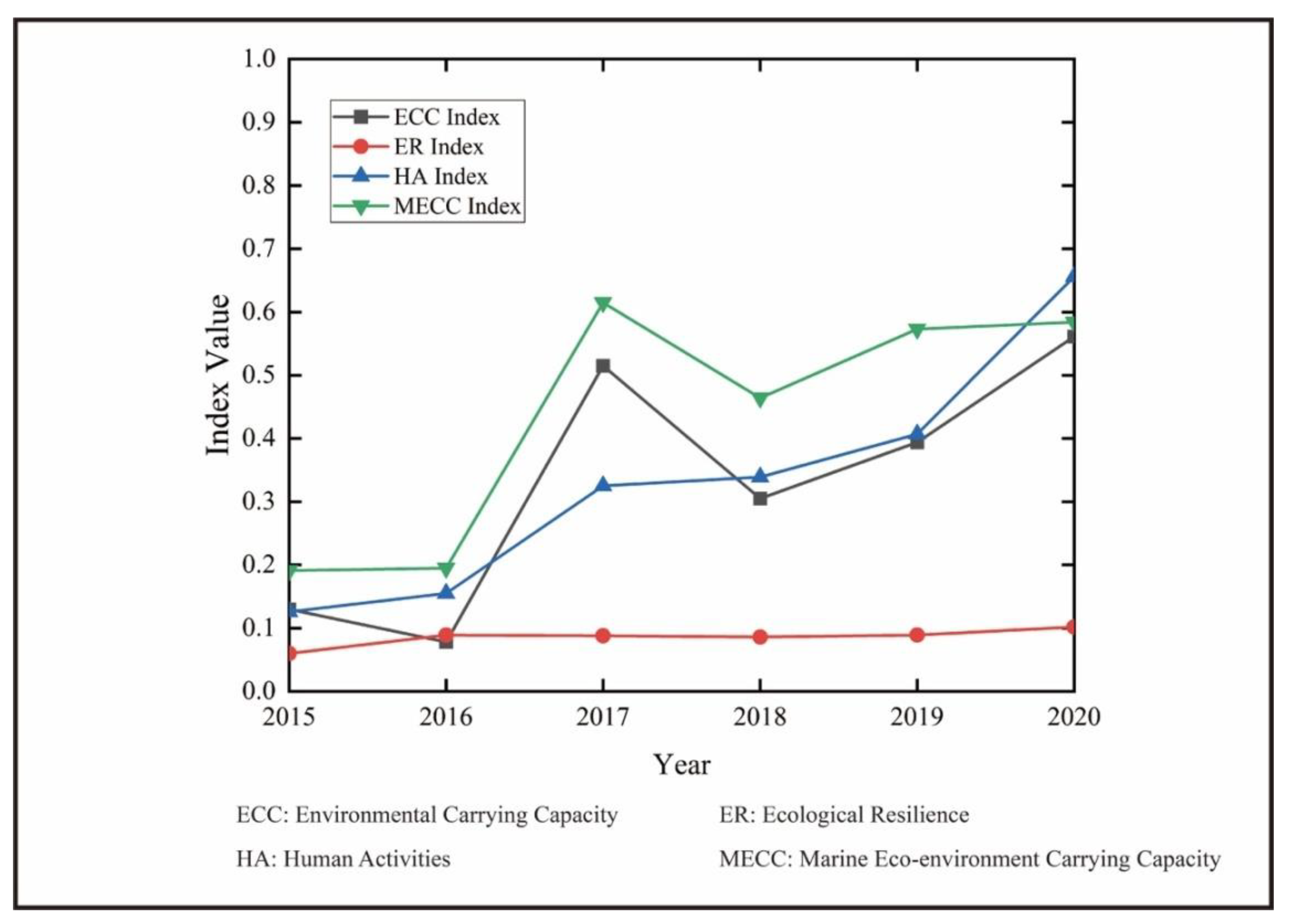
| Target Layer | Criterion Layer | Weight of Each Criterion | Indicator Layer | Weight of Assessment Indicator | Indicator Type | |
|---|---|---|---|---|---|---|
| MECC | ECC | State | 0.537 | Eutrophication index | 0.331 | Negative |
| Utilization ratio of environmental capacity | 0.206 | Negative | ||||
| ER | State | 0.036 | Coverage rate of coral reef habitat | 0.006 | Positive | |
| Assessment index of red tide | 0.030 | Positive | ||||
| HA | Pressure | 0.272 | Total amount of river pollutants discharged into the sea | 0.237 | Negative | |
| Area of marine aquaculture | 0.035 | Negative | ||||
| Response | 0.155 | Pollution control investment as a proportion of the GDP | 0.150 | Positive | ||
| Disposal rate of urban sewage | 0.005 | Positive | ||||
| Year | Annual Index Value of ECC | Annual Index Value of ER | Annual Index Value of HA | Annual Index Value of MECC |
|---|---|---|---|---|
| 2015 | 0.130 | 0.060 | 0.126 | 0.191 |
| 2016 | 0.078 | 0.089 | 0.155 | 0.195 |
| 2017 | 0.515 | 0.088 | 0.325 | 0.615 |
| 2018 | 0.305 | 0.086 | 0.339 | 0.464 |
| 2019 | 0.394 | 0.089 | 0.407 | 0.573 |
| 2020 | 0.516 | 0.102 | 0.656 | 0.584 |
Publisher’s Note: MDPI stays neutral with regard to jurisdictional claims in published maps and institutional affiliations. |
© 2022 by the authors. Licensee MDPI, Basel, Switzerland. This article is an open access article distributed under the terms and conditions of the Creative Commons Attribution (CC BY) license (https://creativecommons.org/licenses/by/4.0/).
Share and Cite
Wu, K.; Chen, K.; Gao, Y.; Jiang, S.; Huang, H. Applying a Set of Potential Methods for the Integrated Assessment of the Marine Eco-Environmental Carrying Capacity in Coastal Areas. Sustainability 2022, 14, 4416. https://doi.org/10.3390/su14084416
Wu K, Chen K, Gao Y, Jiang S, Huang H. Applying a Set of Potential Methods for the Integrated Assessment of the Marine Eco-Environmental Carrying Capacity in Coastal Areas. Sustainability. 2022; 14(8):4416. https://doi.org/10.3390/su14084416
Chicago/Turabian StyleWu, Kankan, Keliang Chen, Yu Gao, Shang Jiang, and Haiping Huang. 2022. "Applying a Set of Potential Methods for the Integrated Assessment of the Marine Eco-Environmental Carrying Capacity in Coastal Areas" Sustainability 14, no. 8: 4416. https://doi.org/10.3390/su14084416
APA StyleWu, K., Chen, K., Gao, Y., Jiang, S., & Huang, H. (2022). Applying a Set of Potential Methods for the Integrated Assessment of the Marine Eco-Environmental Carrying Capacity in Coastal Areas. Sustainability, 14(8), 4416. https://doi.org/10.3390/su14084416







